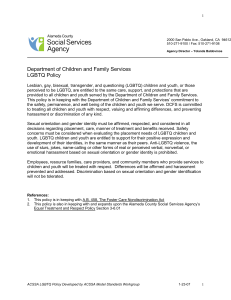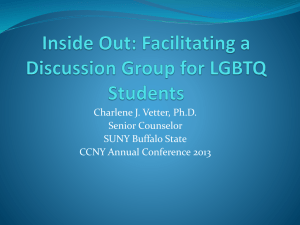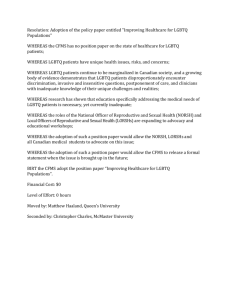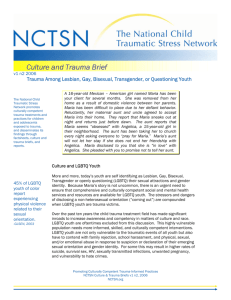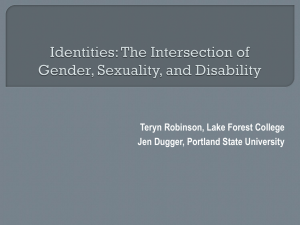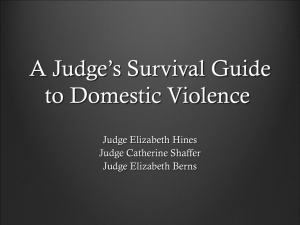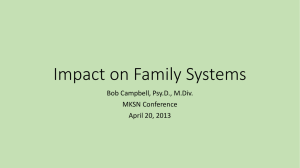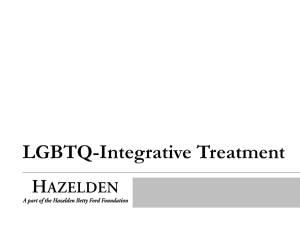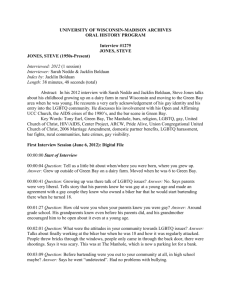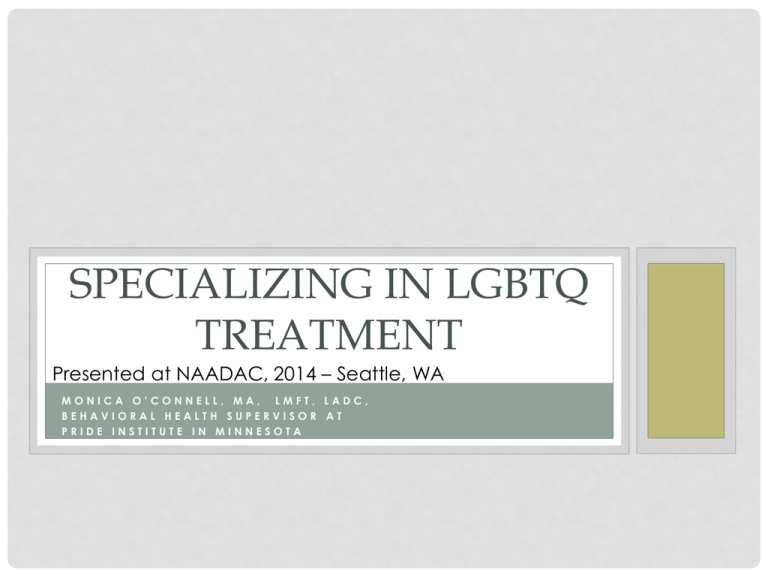
SPECIALIZING IN LGBTQ
TREATMENT
Presented at NAADAC, 2014 – Seattle, WA
MONICA O’CONNELL, MA, LMFT, LADC,
BEHAVIORAL HEALTH SUPERVISOR AT
PRIDE INSTITUTE IN MINNESOTA
A BIT ABOUT PRIDE INSTITUTE
WHO WE ARE
• For over 28 years, PRIDE Institute has *exclusively* helped the
LGBTQ population through substance abuse and mental health
treatment programs.
• Located just 10 miles from the Minneapolis city center, PRIDE
takes a holistic approach in serving the LGBTQ population,
offering Dual Diagnosis licensure, 24-hour nursing care in a
serene, retreat-like setting with a nationally recognized clinical
staff.
• In addition, we are a renowned teaching facility with an
average of 8 interns on staff at all times
• Monica O’Connell MA, LMFT, LADC
• Mental Health Supervisor, PRIDE Institute
• EMDR trained therapist & consultant in training
A BIT ABOUT PRIDE INSTITUTE
Our treatment
program is
preferable to
“one-size-fits-all”,
mainstream
programs
that do not
understand or
address issues
specific to LGBT
individuals.
Contact PRIDE Institute at 1-800-547-7433
www.pride-institute.com
OFFERING TRAUMA-INFORMED CARE
Specializing in Crystal Meth and Sexual Compulsivity programming
• Body Image
• Sexual Health program
• HIV/AIDS Programming
• 3 day Family immersive weekend
• PRIDE Sober Support Program.
OBJECTIVES
• Understanding LGBTQ inclusive identification
and terminology
• Discuss impact of trauma (e.g., internalized
homophobia, micro-aggressions, bullying) on
LGBTQ clients and their resulting chemical use.
• Identify best practices to serve the LGBTQ
community, including specialized and exclusive
services.
JUST THE FACTS
• 30-40% of the LGBT Community is addicted, in
contrast to 10 percent of the population at large
• 46% of lesbian and gay men in treatment have had
homophobic therapist
• 34% felt their sexuality was seen as irrelevant
• 7% had therapist who made openly negative
comments about their sexuality
LGBTQ
Definitions: Lesbian, Gay, Bisexual, Trans*,
Queer
Understanding Client’s:
•
•
gender
•
sexuality
expression
DEFINING TRANSGENDER
• Transgender is an umbrella term for people
whose gender identity differs from what is
typically associated with the sex they were
assigned at birth
• Being transgender is not dependent on
medical procedures or the taking of
hormones
TERMINOLOGY
1.
Assigned Sex at Birth: a person's sex is determined by a number of
factors - not simply genetics - and one's biology does not "trump"
one's gender identity. People are born babies - they are not "born a
man" or "born a woman.“
2.
Transgender: people whose gender identity, expression or behavior
is different from those typically associated with their assigned sex at
birth.
3.
Cisgender: A term used by some to describe people who are not
transgender. "Cis-" is a Latin prefix meaning "on the same side as,"
and is therefore an antonym of "trans-."
4.
Gender Non-conforming: individuals whose gender expression is
different from societal expectations related to gender.
PRONOUNS
• Trans Woman: trans individual that identifies as a woman
• Trans Man: trans individual that identifies as a man
• Genderqueer: used by some individuals who identify as
neither entirely male nor entirely female
• Two Spirit: People who display characteristics of both male
and female genders. Sometimes referred to as a third gender
– the male-female gender. The term is derived from the
traditions of some Native North American cultures.
LGBTQ, TRAUMA & ADDICTION
• High incidence of trauma in LGBTQ
community
• Increased rates of trauma for LGBTQ
individuals who use chemicals.
• Trauma and addiction memories
LGBTQ-SPECIFIC TRAUMA IMPRINTS
•
Heterosexism
•
Bullying
•
Attachment injuries related to identity within the LGTBQ
community
•
Homophobia
•
Transphobia
•
Internalized Homonegativity
CHEMICAL USE STARTING AS A SOLUTION
Client’s describe use memories and earliest use
periods to include reasons such as:
• “Then I could fit in.”
• “I was so isolated and this helped me feel
numb.”
• “It was the first time I felt like I was
attractive and could really be free to be
myself.”
PRIMARY GOAL OF TREATMENT IS TO
CREATE CLIENT SAFETY
•
Trauma-informed Care
•
Addressing Internalized Homonegativity
•
Creating an environment of inclusion through LGBTQ-informed &
specialized care
•
Mental Health
•
Shame
•
Body image
•
Healthy relationship models
TREATMENT INTERVENTIONS
•
Creating community through LGBTQ exclusive environment and
addressing:
•
Sexual Health
•
Trauma
•
Mental Health
•
Shame
•
Body image
•
Healthy relationship models
SEXUAL HEALTH
And the necessity of
• Re-introducing intimacy definitions
• Sex Positive experiences &
conversations
• Emphasis on re-defining sexual health
TRAUMA
• Helping client’s understand trauma
• ‘Big T’ trauma; ‘little t’ trauma; community
violence and trauma
• Trauma occurrence during
developmental tasks
• Coming out stories
• Family response to identification in the
community
MENTAL HEALTH
• Understanding the impact of mental
health on the LGBTQ community and
chemical health
• Examining mental health diagnosis and
the LGBTQ community
• Early diagnosis vs. coming out stories
• Chemical use induced symptoms vs
mental health
• Complex trauma vs. Axis II diagnosis
BODY IMAGE
• Impact of culture on body image
• Understanding body/gender dysphoria
• Use of chemicals in reference to body
image
HEALTHY RELATIONSHIPS
• Defining Self within relationships
• Allowing Clients to define “Family” &
“Relationships”
LGBTQ CONSIDERATIONS
• Inclusive lodging (bedrooms, gender neutral
bathroom facilities)
• Informed paperwork and assessment
questions
• Addressing family of origin & family of
choice
EXCLUSIVE & INCLUSIVE TREATMENT
MODELS
• Priority placed on meeting the client’s
specific needs.
• Creating safety in client groups and
relationships.
• Easier in exclusive environments
• In an inclusive environment, institution
needs to address heterosexual
privilege and its presence in groups
EXCLUSIVE & INCLUSIVE TREATMENT
MODELS
LGBTQ-informed Staff
• Starting at intake
• Specific LGBTQ training
• Trans* specific education
WHAT IS HETEROSEXISM
• System of attitudes, bias, and discrimination in favor
of opposite-sex sexuality and relationships. Where
being heterosexual is the “norm”.
• What is Heterosexual Privilege?
• Can you give examples of Heterosexual Privilege?
EXAMPLE OF HETEROSEXISM
• Assuming everyone is heterosexual.
• Discrimination against lesbians, gays and bisexuals.
• Assuming heterosexual “norms” apply to all people,
relationships and situations.
PRIVILEGE
• White Privilege
• Male Privilege
• Female Privilege
• Straight Privilege
Other Privilege lists:
http://www.amptoons.com/blog/archives/2006/09/26/a-list-of-privilege-lists/
BODY IMAGE
• Understanding Body/Gender Dysphoria in the Trans*
community
• Use of drugs & alcohol in reference to body image
• Understanding the culture of body image and how
it relates to LGBT individuals
GRIEF AND LOSS
•
•
•
•
•
•
•
•
Rejection of family/friends
Sexual abuse/violence
Unspeakable deaths
Loss of Relationships
Loss of self
Death of significant people/pets
Loss of community
Loss due to sobriety
ANXIETY AND DEPRESSION
• LGB individuals have higher rates of co-occurring
disorders than heterosexual individuals
• 62% of Transgender people have experienced
depression
• 41% of Trans* people have attempted suicide in
comparison to 1.6% of the general population
• Understanding the brain chemistry as well as the
environmental struggles of anxiety & depression
SHAME
• “Shame corrodes the very part of us that believes
we are capable of change.”
-Brene Brown
• Understanding how shame keeps us isolated and
addicted
SEXUAL HEALTH
• Importance of talking about sex in treatment
• Struggles with/and understanding Intimacy
• Sexual Compulsion
• Sexual Anorexia
• Setting specific goals with regards to sex and
relationships with a sex-positive approach
TRAUMA
• Fear of violence
• Sexual violence/abuse
• Bullying
• Physical violence/abuse
• Emotional abuse
• Domestic
violence/abuse
• Effects of Invisibility
• Institutionalized
Harassment
RESOURCES
• TransMontana by Roberta Zenker
• Second Son by Ryan Sallans
• My Gender Workbook by Kate Bornstein
• A Queer and Pleasant Danger by Kate Bornstein
• Transgender History by Susan Stryker
• Running on a Mind Rewired by Nate Cannon
• Trans (Documentary)
• Just Gender (Documentary)
QUESTIONS?
REFERENCES
• www.itspronouncedmetrosexual.com
• www.avp.org
• www.fenway.org
• www.nalgap.org
• www.runningrewired.com
• www.transmontanathebook.com

